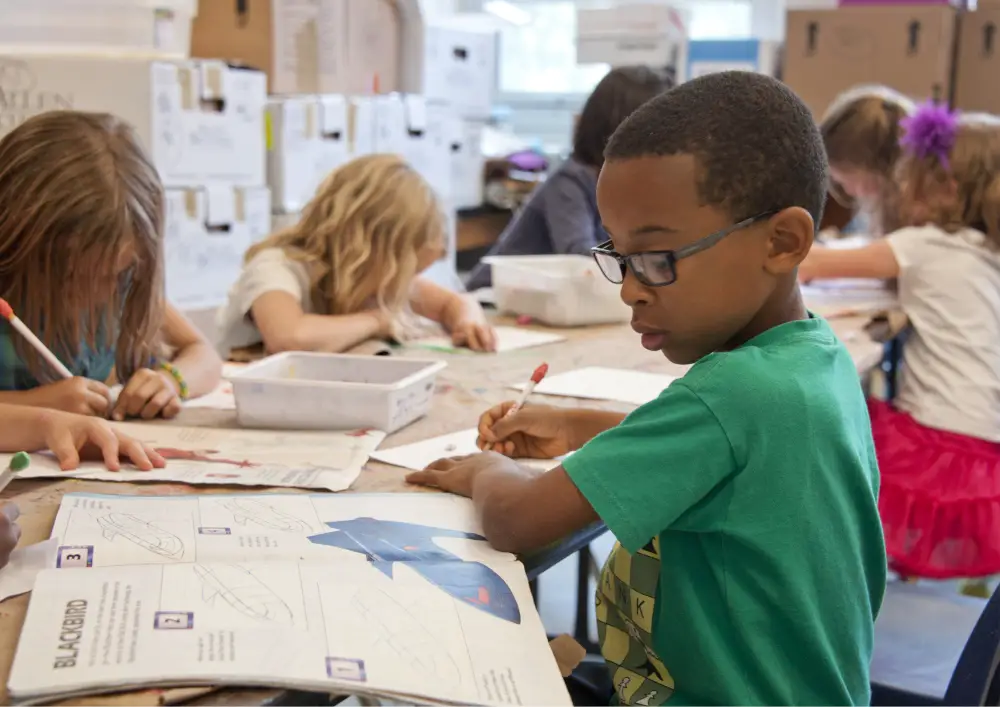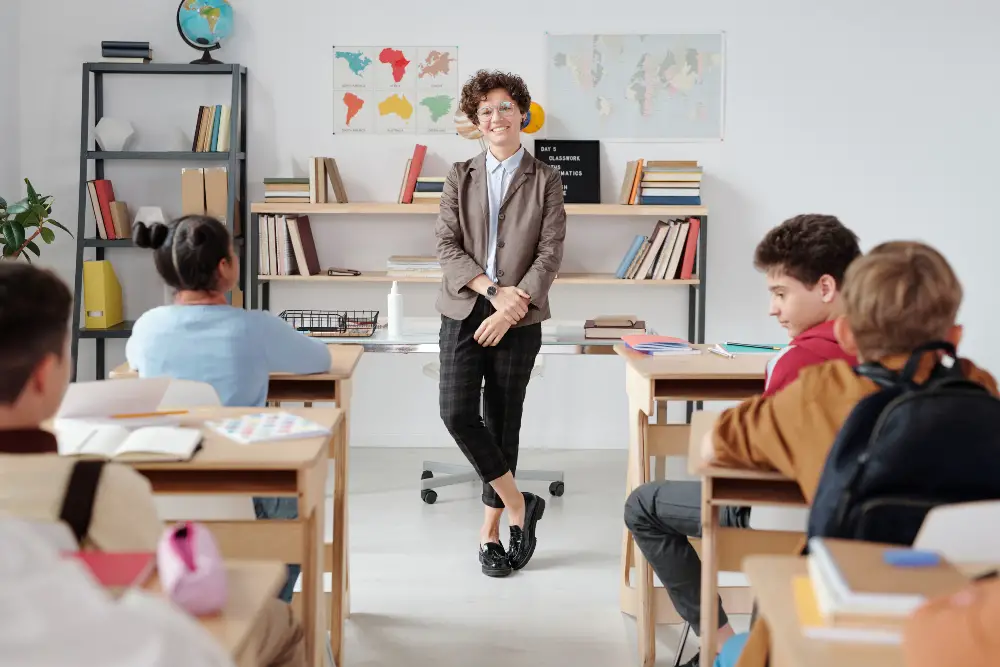Sending your kid to school is a big deal. You need to know how much it will cost. This isn’t just about school fees. You must also consider getting them there, feeding them, and other stuff. Most parents are shocked at how much they spend each year to give their kids a good education.
This article will discuss the fees you must cover when sending your kids to school. We’ll also look at ten countries to show you how costs vary.
Contents
What Adds to the Cost
School costs are more than just fees. They have many parts. We’ll look at what makes up the full cost.
Tuition or School Fees
Tuition is often the biggest cost for parents. In public schools in the U.S., education is mostly free. But many opt for private schools. Here, tuition can be a huge burden. Costs can range from $5,000 to $25,000 annually or even more.
Some countries have free education up to a certain age. Yet, extra courses or private tutoring can add up. College or university will be a separate cost, so start saving early. The tuition fee is a big chunk of your budget. Make sure to look at scholarships and grants. They can help lighten the load.
Transportation
Getting your child to and from school isn’t always free. If you’re driving them, consider gas and wear on the car. Some schools offer a bus service. This usually has a fee. In some countries, public transport is free for students. But in others, you pay a standard fare.
Some places have a school bus fee of around $200 to $400 per year. Carpools are another option. They can split the cost among parents. So, transportation is another piece of the puzzle. Plan your budget to include these costs.
Daily Meals
Feeding your child during school is a daily expense. Public schools in the U.S. might offer free or reduced-price lunches. But many families spend about $2.50 to $4.00 per meal. In countries like Sweden, school meals are free.
Bringing a packed lunch is an option. But remember, this also has a cost. You’ll need to buy the groceries. Lunches can range from simple sandwiches to more elaborate meals. Either way, daily meals are a constant expense. Include this in your budget to avoid surprises.
Supplies and Books
School supplies are a must-have. Notebooks, pencils, and erasers are just the start. In the U.S., parents spend about $100 to $200 per year. In other countries, the list can be shorter and cheaper. But you still need to budget for this.
The school might provide textbooks. If not, used books are another way to save money. Check for online versions, too. They can be less expensive. So, supplies and books are other areas to plan for in your budget.
Other Costs
Extra activities can add up quickly. Sports, arts, and clubs often have fees. In the U.S., it can be around $100 to $500 per year. In other countries, it varies. But it’s a cost you should expect.
Field trips are another expense. They can range from $20 to $50 each. Uniforms are needed in some schools. The fees can add another $100 to $200 to your yearly costs. So, don’t forget to add these to your budget.
These are the key costs you’ll face. Knowing them helps you plan and budget.
United States
In the United States, the cost of education varies a lot. Public schools are mostly free, but there are many other expenses.

Public Schools vs. Private Schools in the U.S.
Public schools in the U.S. are often seen as cost-free options. But parents still need to consider some expenses. These include transport and meals. Public school buses are free in certain states like California. In others, there may be a fee. School meals can also cost money unless a family qualifies for free or reduced lunches.
Private schools come with a different price tag. Tuition is the biggest chunk. On average, it ranges from $10,000 to $45,000 a year. And that’s just the start. Parents also pay fees for tech use, books, and supplies. These extras can add thousands to the bill each year. In some cases, tech fees alone can be over $1,000. Books can cost another $300 to $1,000, depending on the grade and courses.
Now, let’s talk about what you get for your money. Private schools often have smaller class sizes. This means more attention for each student. They may also have more specialized programs connected to arts, sciences, and sports. Schools in certain states offer Advanced Placement (AP) or International Baccalaureate (IB) courses to give kids a jump start on college.
Public schools also have these educational programs. But these can vary significantly from one state to another. Affluent areas often have better-funded schools. This means more programs and newer facilities. Less wealthy areas may have fewer options and older buildings. However, many public schools still offer strong core subjects and extracurricular activities.
Education Programs in the United States
The U.S. government has several education programs that provide financial help to students. Here are the most common programs you apply for:
- Title I Program – This program helps schools with many low-income students. It gives them extra money for resources.
- IDEA Grants – Money for schools to help students with special needs. Covers K-12 and also younger kids.
- Pell Grants – Usually for college, but some high schoolers can use it for dual enrollment classes.
- Head Start – A program for younger kids, even before K-12. Helps with learning and social skills.
- 21st Century Community Learning Centers – These are after-school programs. They offer extra help with homework and skills.
- School Lunch Program – Free or low-cost meals for students. Helps kids focus better on learning.
- GEAR UP – Stands for Gaining Early Awareness and Readiness for Undergraduate Programs. Helps prepare kids for college.
The U.S. has a range of education costs. Knowing what to expect helps you budget better.
Canada
Canada offers a strong education system. There are many choices, but two main options are public and private schools. You also have several financial aids available to Canadian residents for your kid’s schooling.
Public School vs. Private School in Canada
Public schools in Canada also come with hidden costs. Transport is one example. While some areas offer free school buses, others do not. Meals are another. School lunches can add to your monthly bills unless there’s a subsidy.
Private schools in Canada are a whole other story. Tuition can range from $15,000 to $30,000 for day schools. Boarding schools cost even more, between $63,000 and $83,000 a year. Tech fees, books, and supplies are also added costs. These can push the total even higher.
The quality of education varies too. Private schools often have smaller classes for a personal and effective teaching method. They also offer specialized programs. For example, music, arts, or advanced sciences. Public schools offer a good range of subjects but may have fewer extras. Facilities and programs can differ greatly depending on the area.
Education Programs in Canada
When you need financial help, below are several educational programs you can sign up for:
- Canada Child Benefit – A monthly payment to help parents with raising kids. Some families use it for education.
- Provincial School Grants – Some provinces offer grants to help cover school costs for K-12 students.
- After-School Programs – Funded by the government to provide extra learning and activities for kids.
- Indigenous Education Programs – Special funds and resources for Indigenous students in the K-12 range.
- Nutrition Programs – Some provinces offer free or low-cost school meals to ensure kids can focus on learning.
- School Supply Programs – These help families who can’t afford the basics like books and pens.
- Language Programs – For children who speak a different language at home, extra language classes help them keep up in school.
- Special Education Grants – Money for schools to help children with special needs get a good education.
Whether public or private, your choice depends on what you can afford and what you value in an education.
United Kingdom
You can choose between public and private schools for your child’s education in the UK. But the costs and what you get for your money differ in each type.
Public School vs. Private School in the UK
Public schools in the UK have some hidden costs, too. Think about transport. Some areas have free buses, but not all. What about meals? Some schools offer free or low-cost lunches, but that’s not always the case. Uniforms, books, and field trips also add up.
Private schools are even pricier. The average fee is £15,200 a year. That’s way more than the £8,000 spent per pupil in state schools. The gap has grown over the years. Private schools also charge for extras like uniforms, trips, and tech fees. That makes the cost even higher.
The quality of education can vary. Private schools often have small classes and top-notch facilities. Public schools can offer quality but may lack extras like advanced science labs or music programs. School choice often comes down to what parents can afford and what they want for their kids.
The UK has a wide range of schooling options. Private schools offer more but cost a lot. Public schools are more budget-friendly but may have fewer resources. Picking the right one depends on what you value most for your child’s education.
Education Programs in the UK
When you need financial help, below are several government programs to help UK students.
- Pupil Premium – Extra funding for schools to help students from low-income families.
- Free School Meals – Provides free lunches to students in need.
- Special Educational Needs (SEN) – Support for kids who need extra help, like those with learning difficulties.
- Gifted and Talented Programs – Extra activities and lessons for high-performing students.
- English as an Additional Language (EAL) – Support kids who speak another language at home.
- After-School Clubs – Beyond homework help, offer skill-building activities like cooking or coding.
The choice between public and private schools in the UK is big. Cost is a huge factor. But think about what is best for your child’s needs.
Germany
Germany offers robust education options. Students can go to public or private schools. Let’s look at the costs and benefits of each.
Public School vs. Private School in Germany
In Germany, most students attend public schools. These schools are tuition-free. Yet, “free” doesn’t mean there are no costs. Parents may need to pay for textbooks or classroom materials. Some schools charge up to 100 euros a year for these.
Transportation can also be a cost factor. In big cities like Berlin or Munich, a monthly transit pass for a student can cost around 30 to 60 euros. In rural areas, costs can be higher if special school buses are needed.
Lunch programs vary by school. Some offer free or low-cost lunches. Others may charge around 3 to 4 euros per meal. Students often need money for extracurricular activities. Clubs, sports teams, or music programs usually have a fee. These fees can range from 50 to 200 euros per year.
Now, let’s talk about private schools. In 2021, the average tuition for a private school in Germany was around 6,000 to 12,000 euros per year. These costs do not include other fees like uniforms, which can be another 100 to 300 euros. Private schools may also have application fees, which can cost up to 200 euros.
Some families prefer private schools for smaller class sizes or special programs. For example, some schools focus on bilingual education or the arts. However, these perks come at a price. Field trips, study abroad programs, and other extras can add hundreds of euros per year to the cost.
Education Programs in Germany
The German government offers several programs that can help students:
- DigitalPakt Schule – This is a digital pact for schools. It provides funds to improve digital infrastructure, like fast internet and modern devices.
- MINT Initiative – This program focuses on Mathematics, Informatics, Natural Science, and Technology. It aims to foster interest and talent in these subjects from an early age.
- Jugend forscht – Translated as “Youth research,” this is a competition to promote young scientists. It supports students in doing their research projects.
- Cultural Passport – This offers students exposure to arts and culture. It includes museum visits, theatre shows, and music workshops.
- Language Initiative – This program helps students become fluent in a second language. It starts foreign language education as early as kindergarten.
- Dual Training System – Though mostly for older students, this program combines classroom education with on-the-job training. It’s a strong link between school and the working world.
- Schulobstprogramm – This is a school fruit program. It aims to promote healthy eating habits by providing free fruit in schools.
Whether public or private, Germany offers good options. It’s all about what fits the family’s needs and budget best.
Finland
Finland offers many educational opportunities for its citizens. Below is a breakdown of the costs of those opportunities.

Public School vs. Private School in Finland
Public schools in Finland are free. But parents still have some costs. These might include school trips or special courses. Transport is another cost. Fortunately, those in the HSL area can get a 40% student discount for bus trains and metro tickets on the HSL app. Lunch is free in public schools, so parents don’t need to worry about that cost.
Private schools are the better option of the two for high-quality education. Tuition fees can vary a lot. Some private schools may have fees as low as a few hundred euros per year, while others can be several thousand. Transport and meals often have extra costs in private schools. Unlike public schools, private schools don’t usually offer free lunches.
The main difference between public and private is the cost. Public schools might have hidden costs like transport but are generally much cheaper. Private schools offer more amenities and better facilities but at a higher price.
Education Programs in Finland
Finland offers several programs that can help your children with their education:
- Basic Education Program – This is the standard K-9 education program in Finland. It covers all the core subjects and is free of charge.
- Pre-Vocational Program – For students who want more hands-on learning. Focuses on job skills and may include internships.
- Special Needs Education – Tailored programs for students with disabilities or learning challenges.
- Language Immersion Programs – These programs focus on language skills. Students learn subjects in a second language, often Swedish or English.
- After-School Activities – Many schools offer extracurricular programs for arts, sports, and other activities.
- Summer Schools – Short programs during the summer break. They focus on different subjects like science, arts, or languages.
- Gifted Education Program – For students who excel in certain subjects. Offers more challenging coursework.
- Finnish as a Second Language – Aimed at students whose first language is not Finnish. Helps them catch up with their peers in language skills.
- Student Welfare Services – This isn’t a traditional educational program, but it’s vital. The program offers health services, counseling, and other support for students.
- Sports Programs – Offered by many schools, these programs focus on physical education. They may include various sports like soccer, swimming, or skiing.
- Music and Arts Programs – For students interested in the arts. These programs may require an audition or portfolio.
Finland offers excellent options for education, whether public or private. The costs vary, but the focus on student success is a common thread. Choose the best fit for your family, considering quality and cost.
Japan
Japan has a mix of public and private schools. Your child can start at kindergarten and go up to secondary school. Now, let’s look at the costs for both.
Public School vs. Private School in Japan
In public schools, the government covers most costs. But parents still have expenses. Transport to school is often on you. Some places give student discounts for public transit. Lunch is usually not free, so plan for that too.
Private schools cost more. For six years of primary school, you may pay between $17,000 to $73,000. Middle school can range from $12,500 to $34,000 for three years. Secondary school ranges between $20,000 to $30,000 for three years.
Kindergarten in private settings can start at $4,000. Compare this to public schools, which are usually less costly. The gap between public and private widens as you go up in grade levels. Private schools offer more services and extracurriculars but at a higher cost.
Education Programs in Japan
Here are several financial aids to help your kid’s education in Japan:
- Japan Student Services Organization (JASSO) – Offers student scholarships and support.
- Child Allowance – Monthly financial aid for parents with children in school.
- High School Tuition Support Fund – Helps cover high school tuition for families in need.
- Free Preschool Education – For 3- to 5-year-olds from low-income families.
- Subsidized School Lunches – Provides meals at a lower cost in some schools.
- Special Training College Aid – For students in vocational courses.
You can expect those costs when sending your child to school in Japan.
Tips to Save

No one said you must spend so much when sending your kids to school. Here are some ways you can save money.
Buy Second-hand Supplies
School supplies can add up. Buying new isn’t always the best. You can find used books, backpacks, and even laptops. Garage sales, thrift shops, and online marketplaces are good places to look.
Some schools also have swap events. Here, you can trade items you don’t need for ones you do. This saves money and helps the planet.
Carpool to School
Gas costs a lot, and public transport isn’t cheap either. Carpooling helps you and other parents save. Make a schedule with families near you. Take turns driving kids to school.
Carpooling cuts down the number of trips you make. It also lets your children socialize with other children and adults while on the way to school and under your supervision.
Take Advantage of Discounts
School-related costs can hurt the wallet, which is where discounts come in. Many stores, transport, and services offer student discounts. Family discounts can apply to siblings in the same school.
Always ask a clerk or cashier if there is a discount for you. Even small savings add up. And don’t forget to use any loyalty programs or reward cards you have.
Apply for Scholarships
Free money is great. Scholarships and grants don’t need to be paid back. Research online. Speak to school counselors. Many scholarships go unnoticed or unclaimed.
You don’t have to be a top student to get one. There are options based on hobbies, volunteer work, and family background. So apply. The worst they can say is no.
Pack Lunches
School meals can be costly. Packing lunch is a good way to save. It’s also a chance to encourage your kids to eat right. Make a weekly meal plan and buy items in bulk to save more.
Keep easy snacks like fruit and yogurt on hand. Home-cooked meals are usually cheaper and better for you.
These tips can help you cut costs. Every little bit helps when budgeting for school.
Conclusion
School costs can be a heavy burden. But there are ways to make it easier. From picking the right school to saving on daily expenses, every bit helps. It’s all about making good choices for your wallet and your kid’s future.
Remember, a good education doesn’t have to break the bank. With the right strategies, you can provide quality education for your kids without emptying your wallet.






